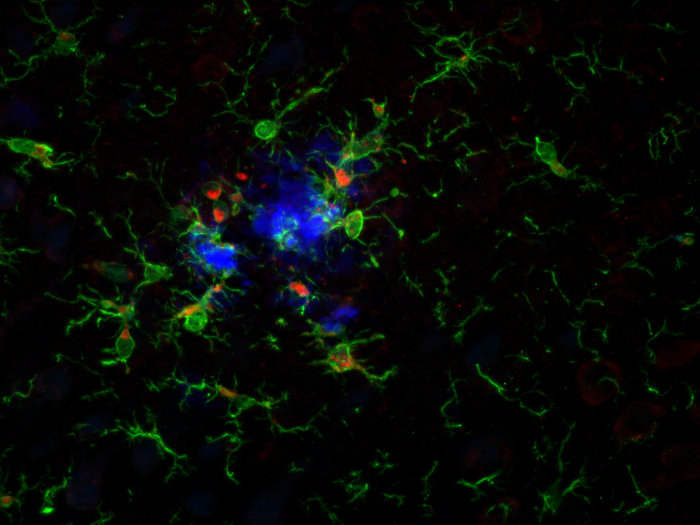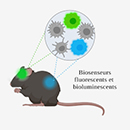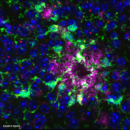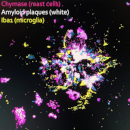Most pathologies of the nervous system are associated with a neuroinflammatory response carried mainly by glial cells, and primarily microglia which are the resident macrophages of the nervous system. In response to a disruption of homeostasis, microglia enter a reactive state that is characterized by transcriptional and functional remodeling leading to the acquisition of an immunocompetent phenotype. Glial reactivity is dynamic and differs from one pathology to another or at a given time.
Purinergic signaling is central in neuron-glia communications. ATP is the main gliotransmitter involved in the regulation of numerous neuronal and glial functions. In pathological conditions, purinergic signaling undergoes significant remodeling with a strong deregulation of the expression of purinergic receptors and an increase in ATP release. This deregulation of purinergic signaling at the level of microglia and astrocytes promotes pro-inflammatory responses.
Our research projects aim to better understand how glial cell signaling is involved in nervous system dysfunctions.
Our work is developed along three main axes:
1- Glial purinergic signaling and inflammation
Glio-transmission is strongly dysregulated in inflammatory conditions. Our interest focuses on the modification of purinergic signaling and its involvement in pro-inflammatory responses. Other recently identified signaling players are also studied.
• Study of the involvement of microglial P2X purinergic receptors in chronic pain and associated comorbidities.
• Understanding the mechanisms of ATP release in pathological conditions (epilepsy, sterile inflammation) through the development of ATP biosensors.
• Relationship between purinergic signaling and inflammasome activation; development of biosensor of IL1ß maturation
2- Inflammation and Alzheimer’s disease
Inflammation caused by microglia is a hallmark of Alzheimer’s disease. This inflammation evolves throughout the development of the pathology and its effects, beneficial or harmful, remain controversial. The team’s data showed that microglial reactivity is present within the parenchyma even before the appearance of amyloid deposits. We are interested in understanding the mechanisms of initiation of the microglial reaction in the context of Alzheimer’s disease. The different axes addressed are:
• Functional roles of Clec7a in the early phases of Alzheimer’s disease.
• Diversity of human microglial cells in Alzheimer’s disease.
• Diversity of microglial cells in a primate model of Alzheimer’s disease.
3- Peripheral immune cells and neuroinflammation
Recent studies demonstrate the recruitment and participation of other types of immune cells in the neuroinflammatory process. In particular, the role of mast cells in neuroinflammatory manifestations is booming. Two axes are addressed:
• Role of mast cells in the early stages of Alzheimer’s disease
• Study of IRAP endosomes as new therapeutic targets in neuroinflammation.
4- Innovative models and tools
To carry out our studies, we rely on innovative models and approaches:
• Development of biosensors applied to inflammation (ATP, IL1ß); BRET and video microscopy
• Murine models of Alzheimer’s disease, in particular the APPNL-F model, an AD knock-in mouse model that expresses a mutated humanized APP.
• High-content transcriptomic analyzes on isolated cells (Nanostring, RNA-seq, and scRNA).
• Translational models, in particular non-human primate models (Collaboration with M. Dhenain, Kremlin-Bicètre) and human induced pluripotent cells (hiPSCs) (Collaboration with C. Crozet, INM, Montpellier)

Reactive microglia (green) clustered around amyloid plaques (blue) express P2X4 receptors (red) in APP/PS1 mice brain.
Team leader

DR1, CNRS

IGF Sud 116

04 34 35 92 85
Know more >
Researchers

CRCN, Inserm

IGF Sud 116

04 34 35 92 85
Know more >

DR2, CNRS

IGF Sud 116

04 34 35 92 85
Know more >

MCF, UM

IGF Sud 116

04 34 35 92 85
Know more >
Technicians and engineers

AI, UM

IGF Sud 116

04 34 35 92 85
Know more >
Postdoctoral researchers and doctoral students

Doctorant(e), Inserm

IGF Sud 114

04 34 35 92 85
Know more >

Doctorant(e), Inserm

IGF Sud 001

04 34 35 92 85
Know more >

Doctorant(e), Inserm

IGF Sud 116

04 34 35 92 85
Know more >

Doctorant(e), UM

IGF Sud 118

04 34 35 92 20
Know more >

Doctorant(e), CNRS

IGF Sud 116

04 34 35 92 85
Know more >

Doctorant(e), UM

IGF Sud 114

04 34 35 93 04
Know more >

Chercheur CDD, CNRS

IGF Sud 116

04 34 35 92 85
Know more >
Fixed term contract technicians and engineers

IE CDD, Inserm

IGF Sud 116

04 34 35 92 85
Know more >

IR CDD, Inserm

IGF Sud 116

04 34 35 92 85
Know more >

IE CDD, UM

IGF Sud 114

04 34 35 92 85
Know more >
Trainees

Master 2, Inserm

IGF Sud 116

04 34 35 92 85
Know more >

Master 2, CNRS

IGF Sud 116

04 34 35 92 85
Know more >

Stagiaire, CNRS

IGF Sud 116

04 34 35 92 85
Know more >

Master 2, CNRS

IGF Sud 116

04 34 35 92 85
Know more >
- Nobili P, Ulman L, Rassendren F, Hirbec H*. Limited contribution of the of P2X4 receptor to LPS-induced microglial reaction in mice. Purinergic Signal 2023 Dec 30. doi: 10.1007/s11302-023-09984-5. PMID: 38159160.
- Weimershaus M, Carvalho C, Rignault R, Waeckel-Enee E, Dussiot M, van Endert P, Maciel TT, Hermine O.Mast cell-mediated inflammation relies on insulin-regulated aminopeptidase controlling cytokine export from the Golgi. J Allergy Clin Immunol. 2023 Jun;151(6):1595-1608.e6. doi: 10.1016/j.jaci.2023.01.014. PMID:
- Gilabert D, Duveau A, Carracedo S, Linck N, Langla A, Muramatsu R, Koch-Nolte F, Rassendren F, Grutter T, Fossat P, Boué-Grabot E, Ulmann L. Microglial P2X4 receptors are essential for spinal neurons hyperexcitability and tactile allodynia in male and female neuropathic mice. 2023 Oct 2;26(11):108110. doi: 10.1016/j.isci.2023.108110. PMID: 37860691
- Hua J, Garcia de Paco E, Linck N, Maurice T, Desrumaux C, Manoury B, Rassendren F, Ulmann L. Microglial P2X4 receptors promote ApoE degradation and contribute to cognitive deficits in Alzheimer disease. Cell Mol Life Sci. 2023 May 5;80(5):138. doi: 10.1007/s00018-023-04784-x. PMID: 37145189.
- Chappe YL, Pierredon S, Joushomme A, Molle P, Garenne A, Canovi A, Barbeau S, Poulletier De Gannes F, Hurtier A, Lagroye I, Ducret T, Quignard JF, Compan V, Percherancier Y. Genetically-encoded BRET probes shed light on ligand bias-induced variable ion selectivity in TRPV1 and P2X5/7. Proc Natl Acad Sci USA. 2022 Nov 16;119(46):e2205207119. doi: 10.1073/pnas.2205207119. PMID: 36343259.
- Chappe Y, Michel P, Joushomme A, Barbeau S, Pierredon S, Baron L, Garenne A, Poulletier De Gannes F, Hurtier A, Mayer S, Lagroye I, Quignard JF, Ducret T, Compan V, Franchet C, Percherancier Y. High-Throughput Screening of Transient Receptor Potential Channel 1 Ligands in the Light of the Bioluminescence Resonance Energy Transfer Technique. Mol Pharmacol. 2021 Sep;100(3):237-257. doi: 10.1124/molpharm.121.000271. PMID: 34127538.
- Hemonnot-Girard A L, Meersseman C, Pastore M, Linck N, Rey C, Chebbi A, Jeanneteau J, Ginsberg SD, Lachuer J, Reynes C, Rassendren F, Hirbec H. Comparative analysis of transcriptome remodeling in plaque associated and plaque distant microglia during amyloid-ß pathology progression in mice. J Neuroinflammation. 2022 Sep 24;19(1):234. doi: 10.1186/s12974-022-02581-0. PMID: 36153535
- Ollivier M, Beudez J, Linck N, Grutter T, Compan V, Rassendren F. P2X-GCaMPs as Versatile Tools for Imaging Extracellular ATP Signaling. 2021 Jan 28;8(1):ENEURO.0185-20.2020. doi: 10.1523/ENEURO.0185-20.2020. PMID: 33380526.
- Audinat E, Rassendren F. Glial Mechanisms of Inflammation During Seizures. Inflammation and Epilepsy: New Vistas. Progress in Inflammation Research 2021 Springer International Publishing 88, pp.45-70. doi: 10.1007/978-3-030-67403-8_3
- Hemonnot-Girard AL, Valverde AJ, Hua J, Delaygue C, Linck N, Maurice T, Rassendren F, Hirbec H*. Analysis of CX3CR1 haplodeficiency in male and female APPswe/PSEN1dE9 mice along Alzheimer disease progression. Brain Behav Immun. 2021 Jan;91:404-417. doi: 10.1016/j.bbi.2020.10.021. PMID: 33190798.
- Rassendren F and Audinat E. Purinergic signaling in epilepsy J Neurosci Res. 2016 Sep;94(9):781-93. doi: 10.1002/jnr.23770. PMID: 27302739.

Development of biosensors for the characterization of inflammation
Principal investigator
Vincent COMPAN
Find out more
Purinergic signaling and pain
Principal investigator
Lauriane ULMANN
Find out more
Roles of Clec7a in Alzheimer’s disease
Principal investigator
Hélène HIRBEC
Find out more
Targeting Mast Cells in Neuroinflammation
Principal investigator
Mirjana WEIMERSHAUS
Find out more
Post-Doctorants
• Meersseman Cédric – FRM – 2014-2015
PhD Students
• Damien Gilabert – 2018-2023
• Vincent Seube –2018-2022
• Anne-Laure Hemonnot-Girard – 2017-2021
• Jennifer Hua – 2015-2019
• Matthias Ollivier –2014-2018
• Sarah Lalisse – 2012-2015
Engineers
• Sandra Pierredon – IR 2019-2022
• Valentin Garcia – IE 2019 -2023
Brain Week
• 2024: Glial cells and neurodegenerative diseases – Hélène Hirbec / Matthieu Prieur / Valentin Garcia – Lycée Jean Monnet Montpellier & Lycée des Garrigues St Clément de Rivière
• 2023: Glial cells: neurons don’t work alone! – Hélène Hirbec – Lecture for the general public
• DECLICS – Dialogues Entre Chercheurs et Lycéens pour les Intéresser à la Construction des Savoirs – Find out more
• Hélène Hirbec – since 2019
• François Rassendren – 2022, 2023
UTT – Université du Tiers Temps Montpellier
• • François Rassendren: Neuroinflammation – January 9, 2023 Montpellier – Find out more



 IGF Sud 116
IGF Sud 116 04 34 35 92 85
04 34 35 92 85
 IGF Sud 116
IGF Sud 116 04 34 35 92 85
04 34 35 92 85
 IGF Sud 116
IGF Sud 116 04 34 35 92 85
04 34 35 92 85
 IGF Sud 116
IGF Sud 116 04 34 35 92 85
04 34 35 92 85
 IGF Sud 116
IGF Sud 116 04 34 35 92 85
04 34 35 92 85
 IGF Sud 114
IGF Sud 114 04 34 35 92 85
04 34 35 92 85
 IGF Sud 001
IGF Sud 001 04 34 35 92 85
04 34 35 92 85
 IGF Sud 116
IGF Sud 116 04 34 35 92 85
04 34 35 92 85
 IGF Sud 118
IGF Sud 118 04 34 35 92 20
04 34 35 92 20
 IGF Sud 116
IGF Sud 116 04 34 35 92 85
04 34 35 92 85
 IGF Sud 114
IGF Sud 114 04 34 35 93 04
04 34 35 93 04
 IGF Sud 116
IGF Sud 116 04 34 35 92 85
04 34 35 92 85
 IGF Sud 116
IGF Sud 116 04 34 35 92 85
04 34 35 92 85
 IGF Sud 116
IGF Sud 116 04 34 35 92 85
04 34 35 92 85
 IGF Sud 114
IGF Sud 114 04 34 35 92 85
04 34 35 92 85
 IGF Sud 116
IGF Sud 116 04 34 35 92 85
04 34 35 92 85
 IGF Sud 116
IGF Sud 116 04 34 35 92 85
04 34 35 92 85
 IGF Sud 116
IGF Sud 116 04 34 35 92 85
04 34 35 92 85
 IGF Sud 116
IGF Sud 116 04 34 35 92 85
04 34 35 92 85






